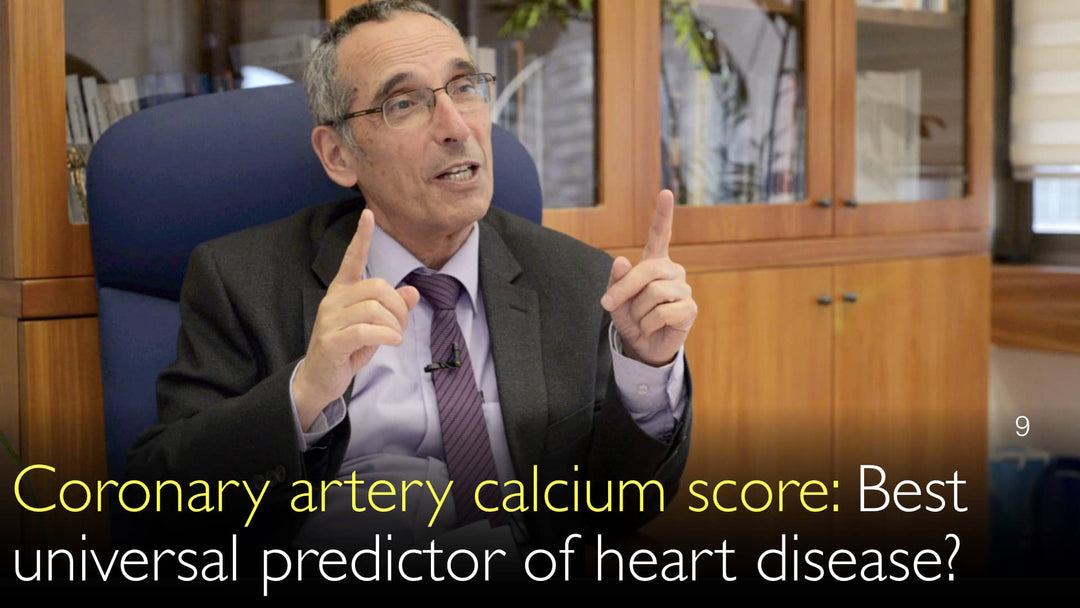O renomado especialista em cardiologia intervencionista, Dr. Jeffrey Popma, MD, aborda as estratégias de tratamento para pacientes com estenose aórtica grave e doença arterial coronariana concomitante. Ele analisa um caso clínico complexo de um homem de 85 anos, detalhando o processo de decisão entre priorizar o implante de válvula aórtica transcateter (TAVR) ou a angioplastia coronariana com stent. O Dr. Popma ressalta como a troca valvar aórtica pode melhorar a perfusão coronariana e reduzir a angina, além de revisar as recomendações atuais das diretrizes para o manejo dessas condições combinadas.
Estratégias Ótimas de Tratamento para Estenose Aórtica e Doença Arterial Coronariana Combinadas
Ir para a Seção
- Desafio da Doença Cardíaca Combinada
- Apresentação do Caso Clínico
- Benefícios da Troca Valvar Aórtica
- Diretrizes de Revascularização Coronariana
- Tomada de Decisão Terapêutica
- Transcrição Completa
Desafio da Doença Cardíaca Combinada
O tratamento de pacientes com estenose aórtica e doença arterial coronariana simultânea representa um desafio clínico significativo. O Dr. Jeffrey Popma descreve essa situação como uma das áreas com menos evidências na cardiologia moderna. A questão central envolve a sequência ideal para abordar essas duas condições. Os médicos precisam decidir se realizam a revascularização coronariana antes, durante ou após a troca valvar aórtica.
Essa decisão tem implicações profundas para a segurança do paciente e os resultados em longo prazo. O Dr. Jeffrey Popma enfatiza a complexidade desses casos durante sua discussão com o Dr. Anton Titov.
Apresentação do Caso Clínico
O Dr. Jeffrey Popma apresenta um caso representativo de um homem de 85 anos com múltiplas questões cardiovasculares. O paciente apresentava estenose aórtica grave associada a doença arterial coronariana extensa. Sua anatomia coronariana incluía uma oclusão crítica de 90% na porção proximal a média da artéria descendente anterior (ADA).
O paciente também tinha uma oclusão de 50% na artéria circunflexa direita. Seus sintomas incluíam desconforto torácico clássico e falta de ar significativa. Esse caso exemplifica a complexidade da tomada de decisão necessária quando múltiplas condições cardíacas coexistem em pacientes idosos.
Benefícios da Troca Valvar Aórtica
A troca valvar aórtica, seja por TAVR ou cirurgia aberta, oferece benefícios fisiológicos significativos. O Dr. Jeffrey Popma explica que o alívio da estenose aórtica melhora dramaticamente a perfusão coronariana. Essa intervenção resulta em uma redução favorável da pressão diastólica final do ventrículo esquerdo.
O procedimento também diminui a demanda de oxigênio miocárdico em todo o coração. Esses efeitos combinados frequentemente resolvem os sintomas de angina sem intervenção coronariana adicional. O Dr. Jeffrey Popma observa que esse entendimento mudou a forma como os médicos abordam o stent coronariano em pacientes com estenose aórtica.
Diretrizes de Revascularização Coronariana
As diretrizes atuais fornecem recomendações específicas para o manejo da doença coronariana concomitante. O Dr. Jeffrey Popma referencia as orientações do American College of Cardiology redigidas pelo Dr. Steve Ramee. Essas recomendações sugerem que a revascularização coronariana permanece indicada para lesões coronarianas específicas.
Lesões da artéria descendente anterior proximal e doença do tronco da coronária esquerda tipicamente requerem intervenção. Segundo o Dr. Popma, a revascularização serve a dois propósitos principais: aumenta a segurança do procedimento valvar aórtico subsequente e aborda possíveis problemas de acesso coronariano que possam surgir após o implante valvar aórtico transcateter.
Tomada de Decisão Terapêutica
A decisão sobre a sequência terapêutica requer consideração cuidadosa de múltiplos fatores. No caso apresentado, o Dr. Jeffrey Popma e sua equipe optaram por abordar primeiro a doença coronariana. Eles implantaram um stent coronariano Synergy longo na artéria ADA criticamente obstruída.
Essa abordagem permitiu estabilizar a circulação coronariana antes de realizar o procedimento TAVR. O paciente foi agendado para retornar para a troca valvar aórtica transcateter um mês depois. O Dr. Popma reconhece ao Dr. Anton Titov que a abordagem ideal permanece incerta para esses casos complexos.
Esse caso destaca a evolução contínua no manejo da doença cardíaca valvar e coronariana combinada.
Transcrição Completa
Dr. Anton Titov: Paciente com estenose aórtica e doença arterial coronariana extensa – como selecionar a melhor opção de tratamento? Tratar a válvula aórtica primeiro ou iniciar com o stent coronariano? Existe um caso clínico que você poderia discutir?
Dr. Jeffrey Popma: Sim. Posso deixar algumas incertezas sobre o que devemos fazer. As áreas mais desafiadoras e com menos evidências em como tratamos pacientes com doença cardíaca diariamente são estas. É a revascularização de pacientes que têm doença coronariana e estenose aórtica concomitante.
Dr. Jeffrey Popma: É difícil decidir se o tratamento da doença arterial coronariana deve ser feito antes, durante ou após a troca valvar aórtica. Vou criar um caso semelhante a um que tivemos algumas semanas atrás.
Dr. Jeffrey Popma: Homem de 85 anos, geralmente saudável, tem uma oclusão longa de 90% na porção proximal a média da artéria descendente anterior. O paciente também tem uma oclusão de 50% na artéria circunflexa direita. Ele também tem estenose aórtica grave. O paciente apresenta sintomas de desconforto torácico. Ele tem falta de ar.
Dr. Anton Titov: Isto é o que sabemos sobre estenose aórtica. São informações novas.
Dr. Jeffrey Popma: Podemos simplesmente aliviar a estenose aórtica com troca valvar aórtica transcateter, TAVI. Ou podemos fazer uma cirurgia cardíaca aberta para trocar a válvula aórtica. Então sabemos que temos uma queda da pressão diastólica final do ventrículo esquerdo.
Dr. Anton Titov: Isto resulta em melhor perfusão coronariana. Isto resulta em menor demanda de oxigênio miocárdico. Estas são todas coisas boas. A angina pectoris desaparece.
Dr. Jeffrey Popma: Aprendemos agora que não precisamos ser tão agressivos com nossos procedimentos de stent coronariano em pacientes com doença valvar aórtica. Porque frequentemente o suprimento de oxigênio miocárdico e a demanda mudam de forma muito favorável. Após fazermos a troca valvar aórtica, o suprimento de oxigênio para o coração também melhora.
Dr. Jeffrey Popma: Entretanto, neste caso particular, o paciente também tinha uma obstrução de 90% na artéria ADA. Pacientes com lesão proximal da artéria descendente anterior ou lesões proximais direitas são difíceis de tratar.
Dr. Jeffrey Popma: Nossas recomendações atuais de diretrizes baseiam-se em um documento de orientação do American College of Cardiology. Foi redigido pelo Dr. Steve Ramee. Eles sugerem que talvez a revascularização coronariana deva ser indicada nesses pacientes. O stent coronariano é indicado por duas razões.
Dr. Jeffrey Popma: Uma razão é tornar o procedimento mais seguro. Isto torna o procedimento de troca valvar aórtica mais seguro. Em segundo lugar, podem haver problemas com acesso coronariano com nossas válvulas aórticas transcateter. Então fazer o tratamento da doença arterial coronariana antes da troca valvar aórtica é melhor.
Dr. Anton Titov: Pode ser melhor do que fazer o stent coronariano após a troca valvar aórtica.
Dr. Jeffrey Popma: Neste caso fizemos a terapia com stent da artéria ADA do paciente. Colocamos um stent coronariano Synergy longo, abrimos o vaso coronariano. O paciente então retornará em um mês. Faremos o procedimento TAVR. Ainda não descobrimos qual é a opção correta a fazer.
Dr. Anton Titov: Há uma combinação de doença arterial coronariana e doença valvar aórtica. Este é certamente um caso muito interessante. É um caso de tratamento de doença cardíaca muito complexo. Professor Popma, muito obrigado por esta conversa muito interessante. Esperamos voltar a você com mais perguntas no futuro. Tenho certeza de que será muito interessante para espectadores ao redor do mundo.
Dr. Jeffrey Popma: Obrigado por me receber!







